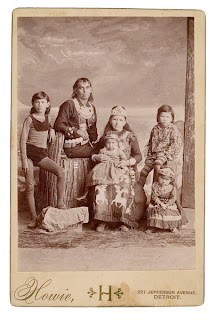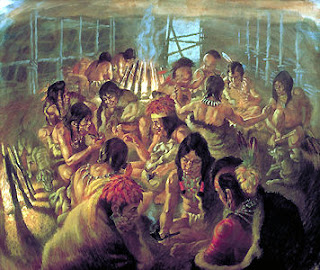Environment:
The Iroquois or Haudenosaunee (People of the Longhouse) are a
Northern American tribe. When the Europeans first came to North America the
Iroquois were all over the northeastern united states west of the Hudson river
in New York State. Today the Iroquois live
in New York, Quebec and Ontario. The
climate for this region is pretty varied.
The average precipitation is about 3 inches a month. The climate can be
as cold as 13 degrees in the winters and not often reaching above the high 80’s
during the summer months. The Iroquois
live in a woodland type area that at one
time was more rural than it is today.
The environment of the Iroquois’ people is a woodland forest
type of ecosystem. The Iroquois are
farmers so these conditions must have proven to be successful for farming. The major environmental stress that the
Iroquois faced was the climate when it dropped down very low or when there was
a lot of snow. Since the Iroquois are farmers, their crops were part of their
lively hood. They have had to adapt to
the climate in order to keep their food source constant. Another way the Iroquois adapted to their
environment was the building of their longhouses. These were wood frame houses
covered with sheets of elm bark. These houses would house an entire clan – which
can be as many as 60 people. The longhouse helped protect the Iroquois from the
elements as the climate dropped down and the snow started to fall during the
winter months.
Adaptations:
One of the biggest physical adaptations of the Iroquois
Indians is their bodily strength and endurance. The Iroquois lived in a
forested area and relied on the timber from the tall trees to build their
longhouses and other structures in their villages. The structures they built
were huge and of course, a lot of lumber was needed.
The cultural
adaptation of the Iroquois people would be the building of the longhouses.
These houses provided shelter for their clans during the winter months which
helped keep them alive in extreme conditions.
The second cultural adaptation would be the role the women
took of farmers while the men went out to do the hunting. This type of
arrangement worked the best for the Iroquois because the women would be close
to their dwellings to tend to the children and the agriculture while the men
went out for days at a time to hunt.
The third cultural adaptation of the Iroquois was that women
held high positions in the tribe. Women are treated equally in the tribe which
is vastly different than most of society.
This is probably because they figured out it was easier to have everyone
happy and working towards the goal of a happy tribe rather than oppressing some
people.
Languages:
The Iroquois have six different languages in their
nations. They are all very similarly
related and are in the same group of Iroquois languages. Mohawk, Seneca, Oneida, Onondaga, Cayuga and
Tuscarora. The most common and universal of these languages is Mohawk. These languages are available in a written
form and widely used.
Gender Roles:
There are two specific genders in the Iroquois nation- male
and female. Females are highly regarded in the nation. They ruled the clans,
elected the chief, took care of all the farming, property and family. The men
were primarily in charge of hunting, trading and war. The chief of the clans
were always men, but elected by women. Both of the genders had a huge role in
medicine, story telling, art and music.
The roles are pretty strict. A woman would never be chief in
the nation and it is not too likely that a man would stay at home with the
children or deal with the home life. In my research, however I read a couple
times that in the modern Iroquois families it is more of a traditional set up
where the man takes care of the farming, hunting, etc. and the woman states at
home with the children and takes care of the homestead. I could not find anything regarding
repercussions of a gender taking on the roles of the other. It seems as if the
Iroquois were pretty content with their roles. I think this has a lot to do
with the equality in their nation. The
children were raised from an early age into their gender roles. Girls would
help their mother with the farming and household duties and the boys would go
with the men to hunt.
Subsistence:
There were three basic subsistence patterns in the Iroquois
nation – gathering-hunting, a mixed hunting/horticulture pattern, and the
horticulture pattern. Their diet
consisted of game, fish wild plants and corn. All of these were abundant in the
northeastern region of the united states. The game and fish were mostly
available year round with the exception of animals that would hibernate. The
roles were definitely split up. The women were the farmers and preparers of the
food and the men were the hunters of the game and fish. By all reports the
Iroquois had a pretty well balanced diet.
The fish and game were abundant in the region and the women had a pretty
good handle on their crops. They would plant certain things depending on the
time of year.
Economic Systems:
They did save food in surplus for the months when it was
harder to grow crops. This ensured that they had a little bit of stock should
their crops freeze over or it was just too cold for anything to grow. The surplus was dried and stored in clay pots
– something the Iroquois are famous for. The meat was dried and also stored in
pots. Each clan was responsible for their own storage and drying of food. The
Iroquois did have a type of currency.
Their money was called “wampum”. They were used as a currency but also
in art. Which means that their art is
valuable because it contains these beads.
Marriage:
The Iroquois had a very equal attitude about marriage. There
is a stigma with other cultures that they aren’t able to choose who they marry
or that they are forced into it. With the Iroquois, marriage is by mutual
consent. The man had no authority over his wife. In fact, a woman could leave
her husband at any time. When a man and
a woman married, the man would come and live in the longhouse where the woman
lived. Each longhouse belonged to a clan. All of the women in the house were in
the same clan. When a man married, he would move to the woman’s clan’s
longhouse. As far as incest, it was forbidden to marry anyone in your own
clan. A few of these questions didn’t
have answers as far as I could tell. Using some reasoning skills, I would
imagine that there wasn’t really a dowry involved in their marriage. Everything
seems very equal with the Iroquois.
Kinship:
As I stated before, the women in a longhouse all belong to
the same clan. When a man and a woman
married, the man would move into the family with the wife and her clan. Their
family lines run through the maternal side.
The most authority in a family would be had by the oldest maternal relative.
Possessions are passed through the female side of the family. When a man joins
the clan, he only brings a few possessions. A weapon and some clothes were
about the extent of what he would bring with him in the move.
Social Organization:
The Iroquois social structure is stratified and egalitarian,
I believe. There are different roles for
the different genders. However, both genders are equal. They just have
different positions.
Political Structure:
Both genders play a big role in the political system of their
tribe. The women elect the chief and can also essentially fire the chief from
his position. Women deal with property, as well. Only a man can be the chief of the tribe. Men
also are the only ones to deal with war. In the case of the chief, he is elected by a
team of women from the clans in the tribe.
Role of Violence:
The Iroquois are generally described as a peaceful people.
However, they have waged war with other tribes or European settlers. They are
known for being very muscular and well built – one of their physical
adaptations. So when they did fight, they were a tough enemy. Another way
violence occurred with them was with opposing viewpoints on social and
political decisions.
Religion:
According to several articles I have read a lot of the
Iroquois mythology has been lost. However, there are some of their religious
stories have been preserved. The Iroquois have a very interesting religion that
they follow. They have a creator god who planted corn in his mother as a gift
to man. There is even an evil party in their religion. The creator god’s name
is Hahgwehdiyu. His mother who he planed the maize seed in to give the gift to
man is Atahensic. The evil character which is Hahgwehdiyu’s twin is
Hahgwehdaetgan. They had several different ritualistic ceremonies. They would
hold a ceremony to cure illness, help with farming and everything in between.
They had six major ceremonies that would be preformed year after year. Maple,
Planting, Green Maize, Harvest and New Year’s festivals. These festivals and
ceremonies were a big part of their lives and culture. Sure, I think they could
get up in the morning and function. However, I think that these things were
very important to the people and provided a lot of unknown answers or helped
them find comfort.
Art:
One of the most known forms of art in this culture is mask
carving. They are known for carving amazing, intricate masks. Outsiders (people
not from the tribe) are not allowed to view these masks. Beadwork is another
art form that is very common. They would
use wampum beads in their artwork which were also used as a currency. Their
beadwork would tell a story or represent a family or clan. The Iroquois were known for their beautiful
clay pots as well, they were both functional and decorative. The same with
their basket weaving. They would use these beautiful hand-woven baskets for
food preparation, medicine storage and other functional uses.
The music of the Iroquois people is very rhythmic. It is made
up of mostly drumming and singing. This music was used as a big part in their
ceremonies as well as for entertainment. A fun fact I came across was that the
Iroquois man would play the flute outside of a woman he liked’s longhouse to
try and romance her.
Performance art would definitely be their ceremonies for
healing, planting or festivals. They would dance and play music during it and
put on a big show for their creator god. They would also use it for
entertainment at their festivals.
Religious art was semi common. They would tell their
mythology stories through bead work or represent the stories in their art or
music.
Cultural Change:
(hangin on the Rez)
I enjoyed learning more about the Iroquois people. The
Iroquois Nation is made up of several different tribes of Indians. Mohawk, Oneida, Onondaga, Cayuga, Tuscarora
and Seneca. One of the reasons why I
chose the Iroquois for my project is because I have spent some time first hand
with the Onondaga. I have a friend who is actually a full Onondaga indian. I
went to New York with him and stayed on the reservation for a week. My project is more focused on the past
Iroquois and not them in the present day. If I was to write about their culture
in present day, it would practically mirror our culture with the exception of a
few ceremonies and such that they still do.
Based on my first hand experience on the Reservation with amazing
people, I can matter of factly tell you that they have been affected by other
cultures. The Onondaga kids are all
walking around with iPods, cell phones and talking about Facebook! The Onondaga are pretty “Americanized” but
they do still hold on to their ceremonies and traditions. It’s like how on
Christmas we do certain “rituals” (ie- put a tree up, open gifts, sing carols,
etc). I think that they still have their
cultural identity but they are definitely not where they were hundreds of years
ago. They ARE in the modern world. They
just live on a Reservation. A lot of the Onondaga don’t even live on the Rez (as
they call it). They are pretty much just every day people. There is a little
bit of a stigma with the older people, however. My friend told me once that
some of the elders on the Rez would call him an apple (red on the outside, white on the inside) because
he liked to play sports with the kids outside of the Rez. (according to him,
Indian kids don’t really like to play sports- or at least the Onondaga’s). I wouldn’t say that they had a strong
influence on the modern world. They’re pretty much just getting up, going to
work, coming home and paying the bills like everyone else.
Bibliography:
http://www.iroquoismuseum.org/




















